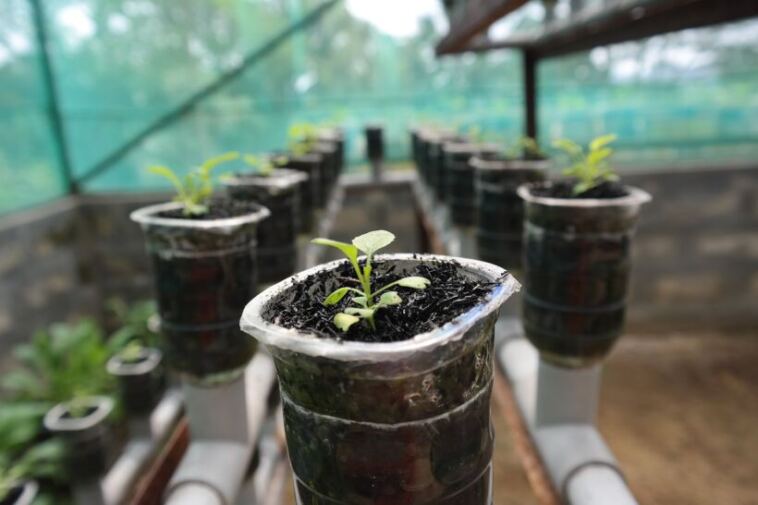- Like
- SHARE
- Digg
- Del
- Tumblr
- VKontakte
- Flattr
- Buffer
- Love This
- Save
- Odnoklassniki
- Meneame
- Blogger
- Amazon
- Yahoo Mail
- Gmail
- AOL
- Newsvine
- HackerNews
- Evernote
- MySpace
- Mail.ru
- Viadeo
- Line
- Comments
- Yummly
- SMS
- Viber
- Telegram
- JOIN
- Skype
- Facebook Messenger
- Kakao
- LiveJournal
- Yammer
- Edgar
- Fintel
- Mix
- Instapaper
- Copy Link
Introduction
While soil-based cultivation has its merits, hydroponic systems have emerged as a preferred method for many due to the level of control they offer.
One of the most critical factors in hydroponic cannabis cultivation is maintaining the right pH level. But what is the best pH for hydroponic cannabis?
Let’s delve deep into this topic.
Understanding pH in Hydroponics
Before we jump into the ideal pH for hydroponic cannabis, it’s essential to understand what pH is. pH stands for ‘potential of Hydrogen’ and is a measure of the acidity or alkalinity of a solution on a scale of 0 to 14. A pH of 7 is considered neutral, values below 7 are acidic, and those above 7 are alkaline.
In hydroponic systems, plants receive their nutrients from a water-based solution. The pH of this solution can significantly influence how well plants can absorb these nutrients. If the pH is too high or too low, certain essential nutrients become unavailable to the plant, leading to deficiencies and poor growth.
The Ideal pH Range for Hydroponic Cannabis
For hydroponic cannabis, the optimal pH range is slightly more acidic than in soil-based cultivation. The best pH for hydroponic cannabis typically falls between 5.5 and 6.5. Within this range, cannabis plants can effectively absorb all the vital nutrients they require for healthy growth.
Why This pH Range is Crucial
Maintaining the pH within the 5.5 to 6.5 range ensures that all essential nutrients remain soluble and available for plant uptake. For instance:
- Macronutrients like Nitrogen (N), Phosphorus (P), and Potassium (K) are readily available within this pH range.
- Micronutrients such as Iron (Fe), Manganese (Mn), and Zinc (Zn) can be easily absorbed by the plant when the pH is slightly acidic.
A deviation from this range can lock out certain nutrients, leading to deficiencies, stunted growth, and even diseases.
Adjusting pH in Hydroponic Systems
Achieving the perfect pH balance requires regular monitoring and adjustments. Adjusting the pH in soil and hydroponic systems is equally critical.
Here’s how you can maintain the ideal pH for your hydroponic cannabis:
- Regular Monitoring: Invest in a good quality pH meter to check the nutrient solution’s pH regularly. Digital pH meters offer accurate readings and are easy to use.
- pH Up and pH Down Solutions: These are commercially available products that can raise or lower the pH of your nutrient solution. Always make adjustments in small increments and retest the pH after each change.
- Flush the System: Over time, nutrient imbalances can cause pH fluctuations. Regularly flushing the hydroponic system with clean water can help reset the pH and prevent nutrient build-up.
Challenges in Maintaining Optimal pH
While understanding the ideal pH range is straightforward, maintaining it can be challenging. Factors that can influence pH in hydroponic systems include:
- Water Quality: The source of your water can affect pH. For instance, tap water often contains minerals that can alter pH. Using filtered or distilled water can help maintain stability.
- Nutrient Solutions: Different nutrients can affect pH levels. It’s essential to choose high-quality nutrient solutions designed for hydroponic cannabis cultivation.
- Plant Growth Stage: Cannabis plants‘ pH preferences can vary slightly depending on their growth stage. Seedlings might prefer a slightly higher pH, while flowering plants might thrive in a more acidic environment.
The Impact of pH on Cannabis Yield and Quality
Maintaining the ideal pH isn’t just about ensuring healthy plant growth; it directly impacts the yield and quality of the cannabis harvest. A balanced pH ensures:
- Optimal Nutrient Uptake: Ensuring that the plant has access to all the essential nutrients it needs to grow.
- Disease Prevention: A balanced pH can prevent the onset of diseases like root rot, which thrive in overly acidic or alkaline conditions.
- Improved Terpene and Cannabinoid Profiles: A healthy plant, receiving all its nutrients, will produce buds rich in terpenes and cannabinoids, enhancing the flavor, aroma, and potency of the harvest.
The Science Behind pH and Nutrient Uptake
Diving deeper into the science of pH reveals its intricate relationship with nutrient uptake. Each nutrient has a specific pH range where it remains soluble, and thus, available for plant uptake. For instance:
- Nitrogen (N) is best absorbed in a pH range of 6.0 to 8.0.
- Phosphorus (P) has an optimal range of 6.5 to 7.5.
- Potassium (K) is most available between 6.0 and 8.5.
When the pH drifts outside these ranges, these nutrients can precipitate out of the solution, making them unavailable to the plant. This intricate balance underscores the importance of regular pH monitoring and adjustment in hydroponic systems.
Advanced Techniques for pH Management
For those looking to master the art and science of pH management in hydroponic cannabis cultivation, several advanced techniques can be employed:
- Automated pH Controllers: These devices continuously monitor the pH of the nutrient solution and automatically adjust it using pH up or down solutions. They can be a game-changer for large-scale hydroponic operations where manual monitoring can be time-consuming.
- Buffer Solutions: These are solutions with a known pH value used to calibrate pH meters. Regular calibration ensures that your pH readings are accurate, leading to more precise adjustments.
- pH Perfect Nutrient Solutions: Some nutrient solutions are designed to auto-adjust the pH of the water they’re mixed with. While they can simplify pH management, it’s still essential to monitor pH regularly to ensure it remains within the optimal range.
The Role of pH in Different Hydroponic Systems
There are various hydroponic systems, each with its unique challenges and benefits concerning pH management:
- Deep Water Culture (DWC): In this system, plants are suspended in a nutrient solution with their roots submerged. Due to the constant immersion, pH stability is crucial to prevent root diseases.
- Nutrient Film Technique (NFT): Plants are placed in a sloped tray, and a thin film of nutrient solution flows over the roots. The constant flow can lead to pH fluctuations, necessitating regular monitoring.
- Aeroponics: Plant roots hang in the air and are misted with a nutrient solution. The high oxygen levels can affect pH stability, making frequent adjustments necessary.
Understanding the nuances of each system can help growers tailor their pH management strategies for optimal results.
Common pH-Related Issues and Their Solutions
Even with the best efforts, growers might encounter pH-related issues. Here are some common problems and their solutions:
- Rapid pH Fluctuations: This can be due to poor water quality or incompatible nutrient solutions. Using filtered water and high-quality nutrients can mitigate this issue.
- Persistent Low pH: Overly acidic conditions can arise from organic matter decomposition or the use of certain additives. Regular flushing and careful selection of additives can help.
- Persistent High pH: This can result from hard water or certain growth mediums. Using pH down solutions or incorporating organic acids like citric acid can help lower the pH.
The Future of pH Management in Hydroponics
With advancements in technology, the future of pH management in hydroponic cannabis cultivation looks promising. Innovations like AI-driven pH controllers, real-time pH monitoring apps, and advanced buffer solutions are on the horizon. These tools will make pH management more precise, efficient, and user-friendly.
Cannabis pH Hacks for Hydroponic Systems
A balanced pH ensures optimal nutrient uptake, leading to healthy plants and bountiful yields. Here are some top cannabis pH hacks for hydroponic systems to help you maintain that perfect balance:
- Lemon Juice & Baking Soda: Before diving into commercial pH adjusters, consider natural alternatives. Lemon juice can effectively lower pH levels, while baking soda can raise them. However, use these with caution and always retest pH after adjustments.
- Regular Calibration: pH meters can drift over time. Ensure you calibrate your pH meter regularly using buffer solutions to maintain accuracy.
- Automated pH Controllers: Invest in an automated pH controller. These devices continuously monitor the pH and make necessary adjustments, ensuring the solution stays within the optimal range.
- Use Quality Water: The source of your water can significantly influence pH. Opt for filtered or distilled water, which offers a neutral starting point, making pH management easier.
- Monitor After Nutrient Addition: Always check and adjust the pH after adding nutrients to your hydroponic system. Nutrients can cause pH fluctuations, so it’s crucial to monitor post-addition.
- Routine System Flush: Over time, nutrient residues can accumulate and affect pH stability. Periodically flush your hydroponic system with clean water to reset the pH and prevent nutrient build-up.
- Stay Informed: The world of hydroponics is ever-evolving. Stay updated with the latest research, techniques, and technologies related to pH management. Joining hydroponic forums or attending workshops can be beneficial.
- Maintain Consistent Temperatures: Temperature can influence pH levels. Ensure your hydroponic system maintains a consistent temperature, ideally between 68°F to 72°F (20°C to 22°C).
- Keep a pH Log: Documenting pH levels, adjustments, and plant responses can offer valuable insights. Over time, you’ll identify patterns, making pH management more intuitive.
- Seek Expert Advice: If you’re struggling with pH imbalances, don’t hesitate to seek advice. Experienced hydroponic growers or experts can offer solutions tailored to your specific challenges.
How-to Video: Testing the pH of Your Hydroponic System
FAQ: Best pH for Hydroponic Cannabis
Q1: What is pH, and why is it important for hydroponic cannabis?
A1: pH stands for ‘potential of Hydrogen’ and measures the acidity or alkalinity of a solution on a scale of 0 to 14. In hydroponic cannabis cultivation, the pH level of the nutrient solution affects the plant’s ability to absorb essential nutrients. An optimal pH ensures that the cannabis plant can take up all the necessary nutrients for healthy growth.
Q2: What is the ideal pH range for hydroponic cannabis?
A2: The best pH range for hydroponic cannabis is slightly acidic, typically falling between 5.5 and 6.5. Within this range, the plant can effectively absorb all vital nutrients.
Q3: How does pH affect nutrient availability in hydroponics?
A3: Each nutrient has a specific pH range where it remains soluble and available for plant uptake. If the pH drifts outside of these optimal ranges, certain nutrients can become unavailable, leading to deficiencies in the plant.
Q4: How can I measure the pH of my hydroponic solution?
A4: You can measure the pH of your hydroponic solution using a pH meter or pH test strips. Digital pH meters offer accurate readings and are recommended for precise adjustments.
Q5: How do I adjust the pH of my hydroponic solution?
A5: You can adjust the pH using commercially available products known as pH Up (to raise pH) and pH Down (to lower pH). Always make adjustments in small increments and retest the pH after each change.
Q6: Can I use natural substances to adjust pH?
A6: Yes, some growers use natural substances like lemon juice or vinegar to lower pH and baking soda to raise pH. However, these methods may not be as precise or stable as commercial pH adjusters.
Q7: How often should I check the pH of my hydroponic system?
A7: It’s advisable to check the pH of your hydroponic system daily, especially after adding nutrients or making adjustments. Regular monitoring ensures that the pH remains within the optimal range.
Q8: Are there any signs that indicate a pH imbalance in my cannabis plants?
A8: Yes, signs of pH imbalance include yellowing leaves, stunted growth, weak stems, and nutrient deficiencies. If you notice these symptoms, it’s essential to check and adjust the pH promptly.
Q9: Does the ideal pH vary based on the growth stage of the cannabis plant?
A9: While the general optimal pH range remains between 5.5 and 6.5, slight variations might benefit the plant based on its growth stage. For instance, seedlings might prefer a slightly higher pH, while flowering plants might thrive in a more acidic environment.
Q10: Are there any advanced tools or technologies for pH management in hydroponics?
A10: Yes, there are automated pH controllers that continuously monitor and adjust the pH of the nutrient solution. Additionally, some advanced nutrient solutions are designed to auto-adjust the pH, simplifying the management process.
Q11: Can the source of water affect the pH of my hydroponic solution?
A11: Absolutely. The source of your water, such as tap water, can contain minerals that influence pH. Using filtered or distilled water can help maintain pH stability in your hydroponic system.
Q12: What should I do if I’m struggling to maintain a stable pH in my hydroponic system?
A12: If you’re facing challenges with pH stability, consider flushing your system with clean water to reset the pH. Additionally, ensure you’re using high-quality nutrients and pH adjusters. If problems persist, seek advice from experienced hydroponic growers or experts.
Conclusion
The world of hydroponic cannabis cultivation offers immense possibilities for growers. By understanding and maintaining the ideal pH, cultivators can ensure that their plants thrive, leading to bountiful and high-quality harvests.
Regular monitoring, using the right tools and solutions, and understanding the unique needs of cannabis plants at different growth stages are the keys to success in hydroponic cultivation.
As the saying goes, “In hydroponics, pH is king.” By giving it the attention it deserves, growers can reign supreme in their cannabis cultivation endeavors.


